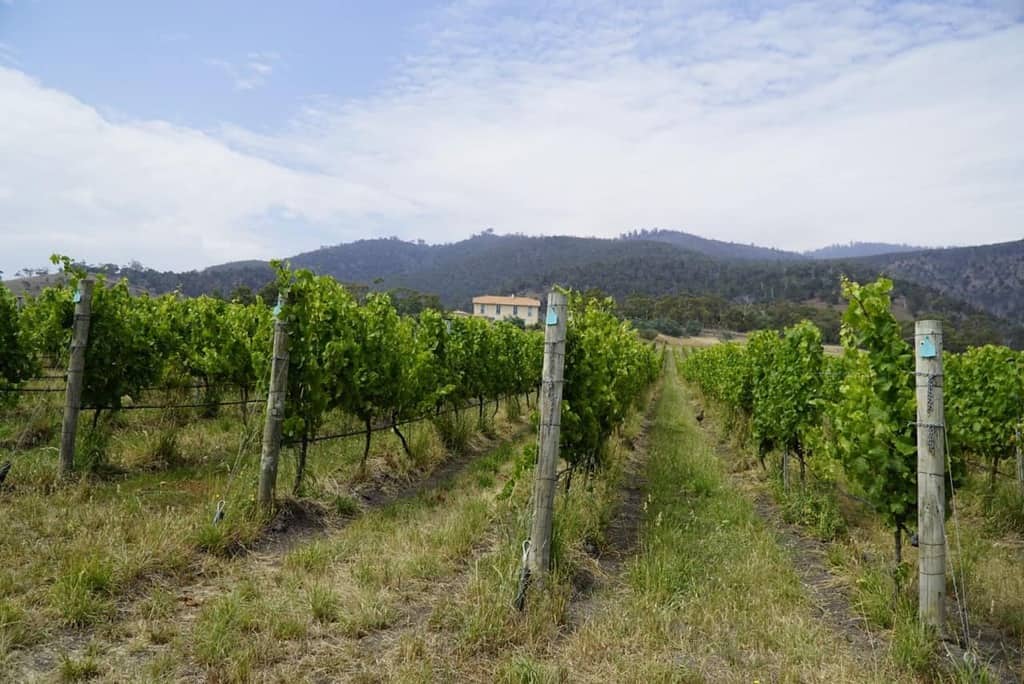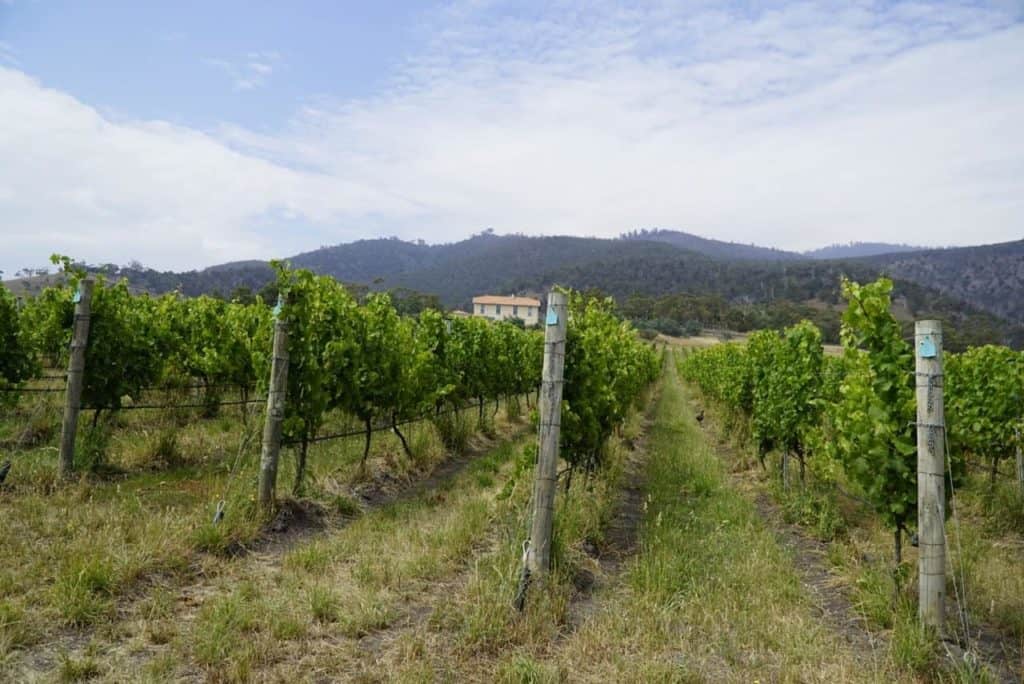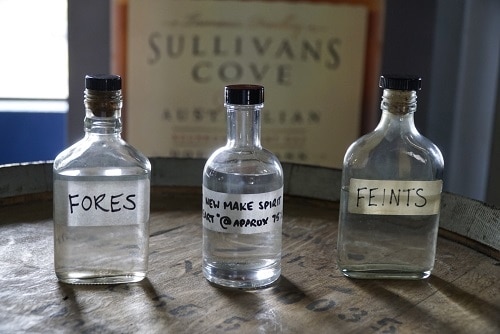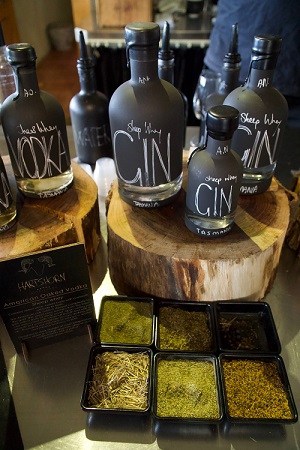For some time now, Tasmania has been appreciated for its favorable climate to grow great Pinot Noir and Chardonnay specifically for Sparking wine. We can all thank the well-known producers of Jansz and Arras for that. There is no denying that there are indeed delicious sparkling wines being made in Tasmania as the climate is ideal for preserving the grapes’ natural acidity. In the interest of this article I will be shedding a light on the non-bubbly libations being made here. Highlights include delicious gin made from sheep’s whey, a range of wine varietals and styles, award winning whiskey, and the must-see cellar door inside an art museum. As amazing as these wines and spirits are, hardly any of them are imported into the USA, so Winetravelers, get your tickets booked and come experience them first hand!
I have been wanting to make it over to Tasmania ever since arriving into Australia. The pristine waters, clean artic air, and lack of people drew me in, and I am glad I went. The untouched nature and the top-quality products coming out of this lush land are unlike anything I have ever had the opportunity to experience before. With the looming threat of climate change constantly lurking in most of Australia, and many wine regions across the world for that matter, Tasmania is and will continue to be a safe-haven for cool climate grapes for decades to come. In fact, the median temperature across the entire growing season hovers in the 50’s at night and 70’s during the day. With a whopping 15+ hours of sunshine a day the grapes are able to concentrate their flavors without ripening too quickly.
How to Navigate the Region
Derwent Valley is located on the River Derwent, a subsidiary of the Tasman Sea. This river is quite long, stretching from the south of the island all the way up to the center. The best place to fly into to get to Derwent is Hobart, from there it is a short drive north into the heart of the region. Although there are some lodging options dotted amongst the wine region itself, I chose to stay in downtown Hobart as there is a bit more action and better dining options in Hobart proper.
Winetraveler Tip: Get notified on the best flight deals into Hobart when they pop up with Airfarewatchdog
Wineries and Attractions To Visit
MONA
The museum of old and new art is a hotspot for tourists and locals alike, featuring a wine bar on the Moorilla winery grounds. Founded by David Walsh, a multimillionaire and professional gambler who (with partners) invested $200 million dollars to found this behemoth, local institution. The museum is seemingly underground with high rock walls stretching four floors up, and displays several controversial art exhibits, each accompanied by audio and written extras on the museum-owned iPods available for guests.
The nooks and crannies within the museum and the dark under-lit accents create an ominous, James-Bond-villain vibe. MONA’s cellar door and the dining outlets on property are, however, the exact opposite. Arranged in an architecturally pleasing way, the tasting room overlooks River Derwent and an outdoor concert space. The beautiful floor-to-ceiling windows give the whole space a bright and breezy feeling.
RELATED: A Travel Guide To Australia’s Mornington Peninsula
The tasting fee is $10 and gives each person the opportunity to taste through both Moorilla and Domaine A’s line of wines. David Walsh purchased Moorilla back in 1995, however, it was not an immediately successful change of hands. It wasn’t until the MONA was open to the public in 2011 and an entirely new state-of-the-art winemaking facility was built, that the brand came into its own. Domaine A on the other hand, is the newest member of the family acquired in mid-2018. If you don’t feel like driving up to the MONA compound in your car, there is a ferry that will take you from downtown Hobart directly to it on the River Derwent.
Moorilla
Moorilla was started by Claudio Alcorso, a brilliant Roman immigrant that made his money in the textile business and is known especially for Sheridan sheets. A man far ahead of his years, he purchased land and planted vines before Tasmania was anywhere close to becoming a well-known wine growing region. The arts have always tied into Claudio’s passions, going back to 1957 when he commissioned the Iconic Australian Architect responsible for the design of the Victorian National Gallery to build two modernist-style dwellings on the estate. The wines from Moorilla are lean with my personal favorites being the Riesling made with plantings dating back to 1962 and their fresh Sauvignon blanc.
Domaine A
Domaine A, the newly acquired estate to David Walsh’s growing portfolio is a much different style and a welcome new addition to the family. Located northeast of Derwent in Coal River Valley, the climate is warmer, allowing for cultivation of thicker-skinned varietals. This estate has Bordeaux in mind, creating deep, dark, ripe, oak-influenced red wines that show a hefty peppery green note. Both Moorilla and Domaine A can be purchased and tasted at the MONA cellar door.
- Hours: Check the website
- Contact: +61 362 779900
- info@mona.net.au
Derwent Estate
A real grass roots operation- their cellar door is located within their original farm house built in the early 1900s. This estate has changed their agri-business numerous times, from sheep to vegetables to poppies and so on, until settling on vitis vinifera. Derwent Estate has now been growing grapes for more than 15 years, supplying for Penfolds. They didn’t begin their own winery until 2014. Penfolds recognized the value of the Derwent Estate’s land and now the Estate can show off its special terroir through their own small-scale winemaking.
RELATED: C is For Chardonnay – Exploring Chardonnay’s History & Wine Styles
The land is notable because of its calcium rich limestone and its aspect, which is ideal for cultivating Chardonnay and Pinot Noir. The actual tasting room is quite rustic, yet their wines are fresh, energetic and express the terroir beautifully. The best part is the very reasonably priced offerings across the entire range and their non-Burgundian offerings such as Moscato, Pinot Gris and Riesling. Beware, however, the tasting room is incredibly small and not advisable for groups.
- https://derwentestate.com.au
- Hours: 10am – 5pm Daily
- Contact: +61 362 635802
- Cellarclub@derwentestate.com.au
Stefano Lubiana
Nestled in the hills of the Derwent Valley, this Italian villa has its own vegetable garden, bee hives, and vines for as far as the eyes can see. Located about fifteen minutes from the MONA and about forty-five minutes north of Hobart, Stefano Lubiana makes a great first stop of the day. Come for the wine, stay for the food. The Italian-inspired Osteria is located adjacent to the cellar door and has some of the best views and dishes in Tassie. Stefano, a 5th generation winemaker, has intuitive winemaking talent in his blood. The wines are pure and made in a classic style showing a true sense of place by only using the vines they have on property and their native yeasts. Their Pinot Noir and Chardonnay are highlights with a delicious and food friendly Merlot, that even though they are no longer making, still have some stock to share! If you ask nicely, they may even share with you a back vintage or two of their Pinot Noir and Chardonnay.
- https://slw.com.au
- Hours: Wednesday to Sunday 11am to 4pm
- Contact: +61 362 637457
- Bookings@SLW.com.au
Institut Polaire
Institut Polaire is located in downtown Hobart and has the street appearance of a wine bar. As a matter of fact, that is exactly how I came across it! After spending a full evening there, I have come to learn that they are much more than what appears on the surface. Institut Polaire is Domaine Simha’s cellar door, a full-service restaurant, and a cocktail/wine bar all in one. The interior is modern with chilling artic-inspired décor of white marble, sheep’s fur, and snow-white walls.
RELATED: Itinerary For Visiting Australia’s Yarra Valley
Institut may have an artic inspired interior, but the team’s hospitality and delicious libations immediately warm you from the inside out. Owned by a husband and wife, Nav and Lee, each is responsible for their own portion of the business. Lee is the mastermind behind Sud Polar Gin and Vodka, a Tasmania-made spirit company featured heavily on their cocktail menu. She can also be found at the helm of the restaurant most days. As for Nav, he is in charge of the winery, Domaine Simha, while also taking his turn at the restaurant. Lee ensured me that one of them is usually at the restaurant during their business hours giving us Winetravelers an opportunity to taste and talk to the very people behind the products.
I must admit, my favorite part about our time was how personal our visit was. Lee cooks the food herself in a tiny kitchen attached to the bar allowing the patrons to watch her craft the meal. The staff takes the time to talk to you as if you were family. The drinks flow free and taste like home in the best way. It all starts feeling like you are a guest welcomed into their home, especially after a martini or two and a flight of wines.
- https://www.institutpolaire.com.au
- Hours: Opens at 3 every day, noon on Saturdays
- *Other times can be booked in advance for cellar door appointments.
Sullivans Cove & Heartshorn Distillery
A quick note on Tassie distilleries, these operations are working on SINGLE STILLS, with the utilization of almost everything exclusively local to Tasmania. To say there is nothing industrial about them is an understatement. The fact that these estates have gained “world’s best awards” and have created such a reach, is no small feat.
Heartshorn Distillery
This estate blew my minds. Driving up to the property it all becomes very apparent that this is a sheep farm. With over 450 sheep on their sprawling property and plenty of feed, grazing land, and views of River Derwent, there is no question these are happy sheep. The story behind the award-winning Sheep’s Whey Vodka and Gin is quite special. The Heartshorn family was struggling to survive off their cheese business, Grandvewe Cheese, also made on property, when Ryan Heartshorn decided he would take matters into his own hands.
Realizing there was a plethora of whey going down the drain after the curds were made, Ryan opted to utilize this byproduct to make a spirit. Self-taught, he has been able to ferment and distil the remaining whey into a delicious and earth-friendly Gin and Vodka. My favorite example of how committed they are to re-use is one of their soft cheeses, which is dusted with the botanicals used to make their gin. The cheese gives off the whey to make the gin, then the gin gives of the botanicals to make the cheese! Such pleasing circularity is hardly ever seen. During a visit, you will see the cheese being made, have the opportunity to taste through the spirits and cheeses they make, and, if you arrive around 3pm, you can even see the sheep milking commence.
- http://grandvewe.com.au/hartshorn-distillery/
- Hours: 10am – 5pm Daily
Sullivan’s Cove
Affectionately known across Australia for their famous French Cask Batch HH0351 that currently goes for over $1,000 per bottle. There is no question that a chance to experience these legendary whiskeys first-hand is worth the trip. Don’t get me wrong, you will not be able to taste this exact bottling, but you will taste their current offerings, including several other award-winning whiskeys. Originally located in a downtown district of Hobart called Sullivan’s Cove, the brand has been around for over 20 years. Due to their continually growing stock of barrels, they moved 15 minutes outside of Hobart to Cambridge. Although the distillery is continually growing their barrel inventory (most whiskeys age a minimum of nine years), the Distillery is only home to one single copper pot still in the French alembic style used to make all of the good stuff. Patrick, the head distiller has been there from almost the beginning and his team of distillers, operating 24 hours a day, is full of individuals with impeccable palates.
- https://sullivanscove.com/the-distillery/
- Hours: 10am to 4pm daily
- Tour & Tasting: $50pp (allow up to 1 hour)
- Tour only: $30pp
- Tasting only: $20pp (allow up to 20 minutes)
Winetraveler tip: Lark and Belgrove are also distilleries in the area worth looking into.
Tasmania is a beautiful place, if you find yourself with a few extra days enjoy some time in the fresh air, a hike up Mt. Wellington, a trip to Bruny Island, or a walk down Wineglass Beach would be a great experience to include while vising this special land.



